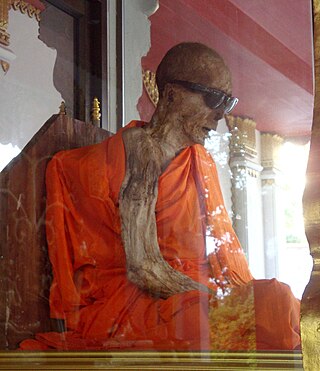Top Qs
Timeline
Chat
Perspective
Buddhist mummy
Incorrupt bodies of Buddhist monks and nuns From Wikipedia, the free encyclopedia
Remove ads
Buddhist mummies, also called flesh body bodhisattvas, full body sariras, or living buddhas (Sokushinbutsu) refer to the bodies of Buddhist monks and nuns that remain incorrupt, without any traces of deliberate mummification by another party. Many were destroyed or lost to history.[1] In 2015, the Hungarian Natural History Museum exhibited a Buddhist mummy hidden inside a statue of Buddha, during its first tour outside China.[2]
This article may contain excessive or inappropriate references to self-published sources. (February 2019) |

Remove ads
Methods
Self-mummification is a common method in China. Examples of Monks who practiced this include Tao Wing (道榮) or Yuet Kai (月溪).[3] Some practitioners have covered their own bodies with clay or salt. According to Victor H. Mair in the Discovery Channel series The Mystery of the Tibetan Mummy, the self-mummification of a Tibetan monk, who died ca. 1475 and whose body was retrieved relatively incorrupt in the 1990s, was achieved by the sophisticated practices of meditation, coupled with prolonged starvation and slow self-suffocation using a special belt that connected the neck with his knees in a lotus position.[4] Some Shingon monks in Japan practiced Sokushinbutsu (即身仏), which caused their own death by adhering to a wood-eating diet consisting of salt, nuts, seeds, roots, pine bark, and urushi tea. They were then buried alive in a pine-wood box with the only opening being a tube for air, meditating in lotus position and occasionally ringing a bell to signal they were alive. When the bell stopped ringing, the box would be dug up and treated as a buddha, granting favor provided it was preserved.[5] Japan banned unburying in 1879, and assisted suicide—including religious suicide—is now illegal.
Remove ads
See also
References
Sources
External links
Wikiwand - on
Seamless Wikipedia browsing. On steroids.
Remove ads
